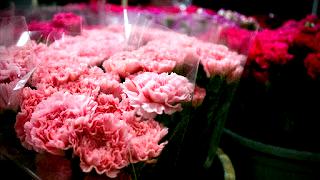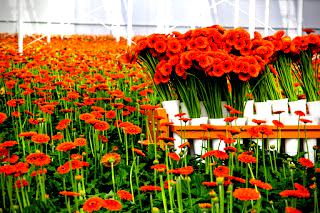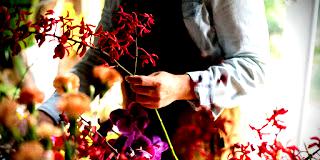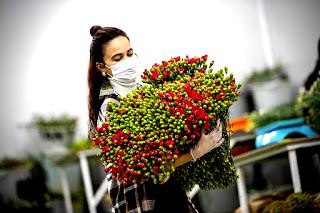How do cut flowers last longer?
Roses are red, violets are blue, your flowers will die, but hopefully not soon.
The flowers are beautiful. But like every piece of beauty Mother Nature gives us, they dry up and die. So is the circle of life.
The good news is that even if a flower arrangement is no longer part of a rooted plant, you can keep the buds tight and the colors vibrant for a reasonable amount of time. As with any living creature, caring for cut flowers is simply a matter of managing and controlling basic conditions: water, food, temperature and bacterial growth.
Water is essential for all life on earth (including you) and plays the most important role in keeping cut flowers growing. So the first thing you should do is make sure they're drinking enough.
Open your bouquet immediately after receiving it and use clean secateurs or shears to prune the stems at a 45-degree angle. This will give your flowers a larger room to drink and prevent them from lying flat on the bottom of the vase. Repeat the cutting daily to further extend the life of your flowers.
Bouquets also often come with lots of ornamental greens to make them look fuller. While some serve an aesthetic purpose, you certainly don't need them all. Just like in the world, the water in the vase is a limited resource, and the more flowers and leaves there are, the less each will be watered.
When you put your flowers in the vase, remove any leaves that fall below the water level. This will also prevent rot and unwanted bacterial growth - we'll get to that in a moment. You can continue to collect some of the remaining leaves, or even remove them all if you want - the less, the more water the flower receives. Then add the accompanying foliage to your branches so you know exactly how much of it you really want to keep.
Finally, you don't drink from the glass that's been there for two days, and neither do your flowers. For truly long-lasting flowers, change the water and give them a squeaky clean vase every 48 to 72 hours.
Food
Yes, your flowers need to eat. But before you start planning twice-daily meals for them, know that feeding your colorful bouquet is child's play, or just as sweet as one.
A flower, while attached to the plant, feeds on carbohydrates produced by the leaves as a result of photosynthesis. When a flower is cut, there are no longer enough leaves to produce food for it, and if you have done some serious plucking, its food supply will be even lower. Add sugar to make up for it. If your bouquet came with a saccharose-rich flower food package, be sure to read the directions and use the correct amount per volume of water. If you don't have flower food, 2 teaspoons of sugar per liter of water will do.
Some websites recommend adding ¼ cup of clear soda to the vase (yes, like Sprite). Just make sure it has sugar in it - diet and "zero" drinks will not work. If you don't have a clear soda on hand, you can even use a dark soda, but it will definitely look a bit gross.
Remember that different types of flowers have different tolerances for added sugar. For example, baby's breath needs more sugar after the buds open, while daffodils make no use of sugary solutions. If you have any doubts, the University of Massachusetts Amherst has put together a table of common flowers and key indicators of how much sugar they need for life in a vase.
Prevent bacterial growth
If you've ever made bread or anything with yeast, you'll know that bacteria love sugar, too. And you definitely don't want too much of those little creatures living in your vase with your flowers.
To inhibit bacterial growth, there are a number of household products that, in the right ratio, will help your flowers grow longer. A small amount of chlorine bleach (as opposed to oxygen bleach) can help get rid of tiny microorganisms – just add ½ teaspoon per liter of water. The downside is that bleach degrades quickly in the presence of water and light (like in a glass vase), so you will need to change the water every other day rather than every other day.
Another way to prevent the growth of bacteria is to lower the pH. Two tablespoons of white vinegar per quart of water will work, but if you want to be really specific, citric acid is the best choice. Citric acid, used in cooking and even to clean a dirty electric kettle, not only lowers the pH, but also makes the water move faster through the flower's internal system. Getting the right amount can be tricky, but you'll need a scale so you can measure 0.35 to 0.5 grams of citric acid per liter or liter of water.
Air temperature
It's a good idea to put your bouquet in the fridge overnight to pretend to be a florist and prolong its beauty - no one will be looking at it longingly at 4am anyway. How viable this is will depend on how much perishable food you currently have in storage and the size of your arrangement. Still, there are other things you can do to help your flowers stay vibrant and cool.
First, there is a place – avoid placing your flowers in direct sunlight and near heat sources such as long-running appliances, desk computers, and heating vents. Avoiding drafts will help prevent dehydration.
Then there is water. Adding ice cubes to the vase helps keep the water cold longer—bonus points if you also use cold water from the fridge.
And stay away from
fruit If you've ever seen a bowl of fruit go bad together as the days go by, know that it's because bananas, pears, and apples don't all agree to control it at the same time. It is due to ethylene gas.
This chemical is released from some fruits and vegetables and stimulates ripening. Plants do this too, and—you guessed it—flowers are affected, too. For this reason, flower and fruit arrangements should never be placed close together.
But if needed, the solution may be in your bar. Alcohol, one of the main ingredients in vodka and other purely distilled beverages, is a known ethylene inhibitor. It has even been used as a dropper to prevent poisoning from ethylene glycol, a toxic ingredient in antifreeze that causes kidney failure if swallowed.
Although the rates vary, the principle is the same. Add 20 milliliters (roughly 1¼ tablespoons) of 40 percent ABV vodka to a quart or quart of water to help your flowers fight this aging gas. Other clear spirits, such as gin, may also work, but you should adjust the amounts so that the alcohol concentration per liter of water is no more than 8 percent.



